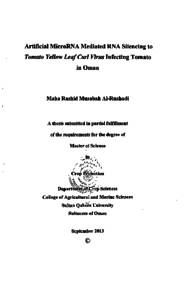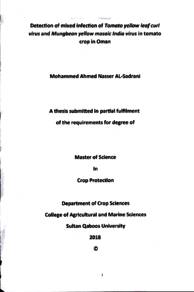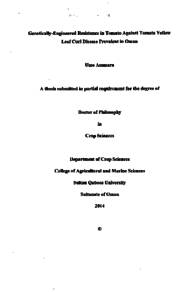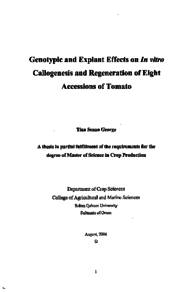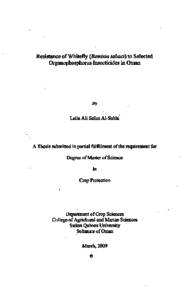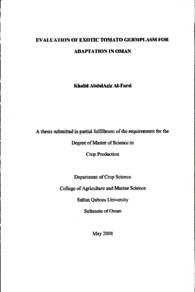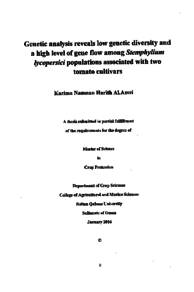وثيقة
Artificial microRNA mediated RNA silencing to tomato yellow leaf curl virus infecting tomato in Oman
الناشر
Sultan Qaboos University
ميلادي
2013
اللغة
الأنجليزية
الموضوع
الملخص الإنجليزي
Tomato yellow leaf curl disease is the most devastating viral disease of tomato and other dicot species caused by Tomato yellow leaf curl virus (TYLCV). TYLCV is a whitefly (Bemisia tabaci) transmitted geminivirus belongs to the family Geminiviridae, genus Begomovirus. The management of the disease in Oman is mainly based on cultural practices and use of pesticides, which is not sufficient to reduce disease incidence. The deployment of host-plant resistance is the most practical mean to control this disease.
MicroRNAs (miRNAs) are short 21 to 23 nucleotide long RNA sequences homologous to target viral Rep sequences with important regulatory role. miRNAs control the expression of target transcripts by binding to complementary sequences leading to cleavage or translational inhibition of the target RNA. Plants carrying sense or antisense transgenes can exhibit spontaneous silencing.
To achieve this goal, sense and antisense transgenes derived from Rep (replication associated protein) ORF of TYLCV-OM driven by 350S CaMV promoter and Nos terminator were synthesized commercially. Susceptible tomato cultivar (Moneymaker) was used as explants and co-cultivated with Agrobacterium tumefaciens strain AGL1 harboring plant expression binary vector carrying miRNA gene. Transformed shoots were selected on kanamycin medium and the presence of the transgene in the primary transformants was confirmed by PCR using CaMV promoter specific primers. Seeds were collected and sown. Integration of amiRNA genes into F1 transgenic plants was confirmed by PCR. F1 tomato seedlings were challenged with TYLCV-OM.
Putative transgenic plants obtained through Agrobacterium mediated transformation have 70% transformation efficiency. Seeds from transgenic plants have been collected to test resistance against TYLCV-OM in F1 generation. Severe disease symptoms of TYLCV infection appeared on susceptible tomato plants whereas no symptoms developed on transgenic plants.
The findings of this study were consistent with previous studies demonstrating amiRNAmediated resistance is an effective silencing strategy to introduce anti-viral transgenes in host plants. Transgenic expression of Rep-specific amiRNAs was found to be an effective method to inhibit TYLCV infection in tomato plants.
المجموعة
URL المصدر
الملخص العربي
يعتبر مرض اصفرار وتجعد أوراق الطماطم من الأمراض الأكثر تدميرا والتي تصيب الطماطم وغيرها من ذوات الفلقتين. المسبب لهذا المرض المدمر هو فيروس يسمى Tomato yellow leaf curl virus . ينتقل هذا الفيروس بواسطة الذبابة البيضاء والتي تعتبر الناقل الأساسي للفيروسات التي تنتمي إلى فصيلة Begomovirus إحدى فصائل عائلة Geminiviridae. إن طرق التحكم في هذا المرض في سلطنة عمان تعتمد بشكل رئيسي على الوسائل التقليدية بالإضافة لاستخدام المبيدات الحشرية. غير انه هذه الطرق التقليدية لا تكفي للحد من انتشار المرض. ولذلك فهنالك العديد من التقنيات التي استحدثت مؤخرا للحد من انتشار الأمراض النباتية. تعتمد هذه التقنيات الحديثة على تطوير مقاومة النبتة المضيفة لمسبب المرض عن طريق استحداث مقاطع قصيره من الحمض النووي الريبوزي والتي ترتبط بنسخ من الجينات ذات الصيغة المكملة مما يؤثر على تعبير تلك الجينات فيساعد على رفع مقاومة النبتة ومنع انتشار المسبب.
في هذا البحث تم استخدام الMicroRNA التي هي عبارة عن سلسلة قصيرة من الحمض النووي الريبوزي تبلغ 21-23 نيكلوتيدات. لاستهداف الجين المرتبط بعملية تكاثر الفيروس (Rep). وتتم عملية إحباط تكاثر الفيروس عن طريق ارتباط MicroRNA بالجين Rep حيث تؤدي عملية الارتباط هذه إلى قطع الجين Rep أو تؤدي إلى تثبيط عملية ترجمته إلى بروتين وبالتالي منع تكاثر الفيروس.
التحقيق هذا الهدف تم تجريب مقطع من الحمض النووي الريبوزي المشتق من التركيب الجيني للجين MicroRNA و من التركيب الجيني للجين Rep من TYLCV - OM . تمت عملية استحداث الجين باستخدام بكتيريا Agrobacterium tumefaciens من سلالة AGLI في داخل النسيج الحي لصنف الطماطم (Moneymaker) والذي يعتبر صنف قابل للإصابة بهذا المرض. البراعم التي اكتسبت المنقول تم تحديدها واختيارها عن طريق قدرتها على النمو في وسط يحتوي
على المضاد البكتيري Kanamycin. وقد تم تأكيد اكتساب هذه البراعم للجين المستحدث باستخدام تقنية PCR. تم جمع البذور من النباتات F0 وزرعها. تم التأكد من انتقال الجينات المستحدثة في نباتات الجيل الثاني F1 باستخدام تقنية PCR. ولفحص قدرة نباتات F1 المكتسبة لل amiRNA على مقاومة الفيروس تم حقن هذه النباتات بالفيروس TYLCV- OM .
النباتات المعدلة وراثيا (المكتسبة للجين amiRNA) باستخدام البكتيريا Agrobacterium أظهرت كفاءة في اكتساب ال amiRNA المستحدث بنسبة 70%. النباتات الغير معدلة جينيا والتي تم حقنها بالفيروس أظهرت أعراض شديدة للمرض على خلاف النباتات المعدلة جينيا حيث انها لم تظهر عليها أعراض المرض بعد حقنها بالفيروس.
تتوافق نتائج هذه الدراسة مع الدراسات السابقة مما يدل على فعالية تقنية amiRNA حيث تعتبر استراتيجية مقاومة فعاله لتثبيط عملية تكاثر الفيروسات في النباتات المضيفة. وقد أثبتت هذه الدراسة فعالية وكفاءة هذه التقنية في مقاومة الفيروس TYLCV في نباتات الطماطم.
في هذا البحث تم استخدام الMicroRNA التي هي عبارة عن سلسلة قصيرة من الحمض النووي الريبوزي تبلغ 21-23 نيكلوتيدات. لاستهداف الجين المرتبط بعملية تكاثر الفيروس (Rep). وتتم عملية إحباط تكاثر الفيروس عن طريق ارتباط MicroRNA بالجين Rep حيث تؤدي عملية الارتباط هذه إلى قطع الجين Rep أو تؤدي إلى تثبيط عملية ترجمته إلى بروتين وبالتالي منع تكاثر الفيروس.
التحقيق هذا الهدف تم تجريب مقطع من الحمض النووي الريبوزي المشتق من التركيب الجيني للجين MicroRNA و من التركيب الجيني للجين Rep من TYLCV - OM . تمت عملية استحداث الجين باستخدام بكتيريا Agrobacterium tumefaciens من سلالة AGLI في داخل النسيج الحي لصنف الطماطم (Moneymaker) والذي يعتبر صنف قابل للإصابة بهذا المرض. البراعم التي اكتسبت المنقول تم تحديدها واختيارها عن طريق قدرتها على النمو في وسط يحتوي
على المضاد البكتيري Kanamycin. وقد تم تأكيد اكتساب هذه البراعم للجين المستحدث باستخدام تقنية PCR. تم جمع البذور من النباتات F0 وزرعها. تم التأكد من انتقال الجينات المستحدثة في نباتات الجيل الثاني F1 باستخدام تقنية PCR. ولفحص قدرة نباتات F1 المكتسبة لل amiRNA على مقاومة الفيروس تم حقن هذه النباتات بالفيروس TYLCV- OM .
النباتات المعدلة وراثيا (المكتسبة للجين amiRNA) باستخدام البكتيريا Agrobacterium أظهرت كفاءة في اكتساب ال amiRNA المستحدث بنسبة 70%. النباتات الغير معدلة جينيا والتي تم حقنها بالفيروس أظهرت أعراض شديدة للمرض على خلاف النباتات المعدلة جينيا حيث انها لم تظهر عليها أعراض المرض بعد حقنها بالفيروس.
تتوافق نتائج هذه الدراسة مع الدراسات السابقة مما يدل على فعالية تقنية amiRNA حيث تعتبر استراتيجية مقاومة فعاله لتثبيط عملية تكاثر الفيروسات في النباتات المضيفة. وقد أثبتت هذه الدراسة فعالية وكفاءة هذه التقنية في مقاومة الفيروس TYLCV في نباتات الطماطم.
قالب العنصر
الرسائل والأطروحات الجامعية

